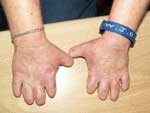HOMOZYGOTES AND COMPOUND HETEROZYGOTES
Variegate porphyria (VP) is an autosomal dominant condition. As such, patients carry a single mutated allele for the protoporphyrinogen oxidase (PPOX) enzyme, inherited from the carrier parent, alongside a normal allele from the normal parent (See Inheritance of porphyria). Very rarely patients are found to have inherited a mutated allele from both parents. If the mutation on both alleles is identical, such patients are homozygotes. If the two mutations are not the same, they are compound heterozygotes.
Potentially such patients are very much worse affected than heterozygotes. Typically they show some or all of the following features:
- Onset of photosensitivity in infancy, rather than after puberty.
- Severe skin changes with photomutilation.
- Developmental abnormalities in bone: short, abnormal fingers are characteristic. Some of this may be due to photo-osteolysis, but there appears to be a developmental aspect as well with disproportionate growth failure in the more distal extremities.
- Sensory neuropathy.
- Neurodevelopmental abnormalities.
- Epilepsy.
Interestingly, surprisingly and completely unexplained, they do not appear to be at increased risk of acute attacks. We have diagnosed four such patients in the South African population (this contrasts with about 50 000 patients carrying typical, heterozygous VP). Two are sisters. The three families are apparently unrelated, and, the two sisters are from a mixed-race family. All the families must however be distantly related—potentially as far back as 1688—since they carry the South African founder R59W mutation. Approximately a further 10 patients have been identified elsewhere in the world.
SEVERITY
The severity depends on the mutations. The mutant enzyme protein produced by at least one of the mutated alleles must express some residual biochemical activity, otherwise the resulting complete haem deficiency is incompatible with life. The greater the residual activity (another way of saying the less severe the mutation), the more benign the clinical effects (See Mutations in the PPOX gene in South African families). This is well seen in the South African patients shown in the accompanying illustration. The young patient in the top frame carries the R59W mutation as well as another fairly severe mutation; the patient in the bottom frame carries the R59W mutation in addition to a second, less severe mutation. You will notice that her hands are much less severely affected.
Despite the frequency of the R59W mutation in South Africa. We have never encountered a true homozygote. The reason is simple: the R59W mutation completely abolishes enzyme activity and a homozygous fetus would not survive. Prof Meissner of our Centre has good experimental evidence for this: using genetic techniques, he has developed a strain of mouse carrying the R59W mutation in its own PPOX gene, and has shown that when two carriers are mated, the growth of the homozygous fetuses are severely retarded and they die in utero at an early stage. See the accompanying figure.
OTHER HOMOZYGOUS PORPHYRIAS
The other autosomal dominant porphyrias: acute intermittent porphyria, hereditary coproporphyria and porphyria cutanea tarda, have all been described in the homozygous or compound heterozygous state. Fewer than 5-10 such individuals are known for each porphyria.
Two of the porphyrias, congenital erythropoietic porphyria and ALA dehydratase porphyria (See Unusual forms of porphyria), are recessive conditions and are found only in homozygotes or compound heterozygotes, and are therefore also extremely rare.
Erythropoietic protoporphyria
Eythropoietic protoporphyria is interesting. Recent work has shown that only those who inherit a mutation on one allele plus a polymorphism which is common in general European populations on the other allele, and which leads to slightly reduced expression of that otherwise normal gene, show clinical symptoms. Such patients are not usually considered as compound heterozygotes since the polymorphism is so common among normal people, being found in about 11% of European populations, including the white population of South Africa. This probably accounts for the fact that EPP is considerably more common than other "homozygous" porphyrias, and for the fact that we have only seen in it in the white population in South Africa.

